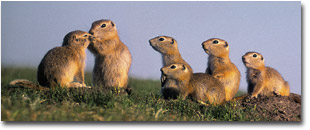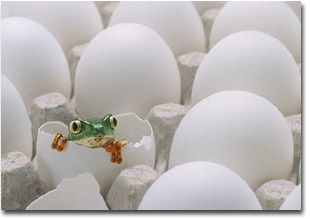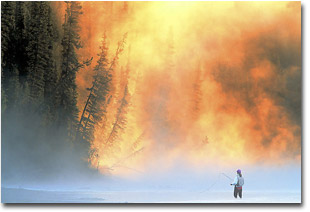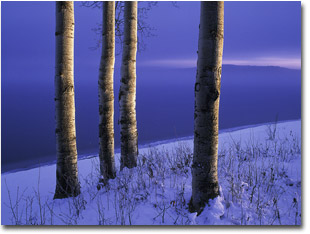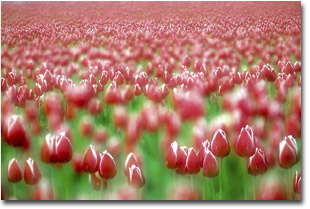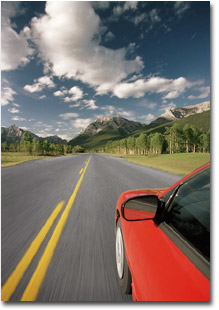|
|
 Same Old, Same Old…Why does all Nature Photography Look the Same?
Text and photography Copyright Darwin Wiggett There has been much discussion and debate on NPN and other online photo forums about the predictable and ‘boring’ repetitiveness of nature photography. The critics point out that nature photography has become a ‘cookie cutter’ genre with all photos looking essentially the same. “You’ve seen one waterfall photo, you’ve seen them all…. Same goes for flower shots, butterfly images, lake reflections, and bird portraits – most everything nature shooters do is clichéd and trite. There is little that is new and exciting in nature photography,” says one particularly vocal critic. I tend to agree, a lot of nature photography does look the same, but I don’t think that’s so bad. The homogeneity of images is more a result of large numbers of shooters at a similar stage of development in photography rather than a lack of creativity by nature shooters. Technical Perfection In the not too distant past, to be a ‘good’ nature photographer only required technical mastery of the craft. I remember my early days in a camera club, the most respected and awed member was the fellow who photographed nesting birds using sophisticated, custom-built, high speed flash. To get his amazing images, he required not only extensive knowledge of bird behavior, but also technical mastery of artificial lighting. He shot everything on a Hasselblad and his 30 by 40 enlargements were mouth-watering in detail. For many members, his work was the pinnacle of achievement, but it could be reached (or should I say, replicated) by simply learning the details of his techniques.
Although his images were technically perfect, they seemed to lack emotion and after viewing 20 or 30 of his images, they all started looking the same. They were formula images. They soon got boring. Familiarity bred contempt. I believe we have reached a similar place in the field of nature photography. No longer is technical excellence enough to make you stand out in the field. Almost everybody has technically excellent photos (just check out the NPN galleries for proof). Now we are longing for something more…. Personal Style or… Gimmick? For me technical mastery of photography came easy. But, I noticed that among those photographers whose work I admired there was an individual ‘flavor’ to their photos that went beyond pure technical quality. There was a little something that immediately told me when I was looking at a Tim Fitzharris, a Galen Rowell, or a Frans Lanting shot. What was that little ‘extra’? “Ah”, I thought, “it is about the subtle use of a special technique or point of view, that others are not using”. For example, Tim Fitzharris’ waterfowl portraits of the 80’s were all shot from right at the water level (in a special floating blind) and he was careful to capture wonderful moments of intriguing behavior. Nobody else at the time seemed to be able to do with waterfowl what Tim did. The same could be said for Galen Rowell’s work. At the time, his landscape imagery stood apart. His pioneering work with grad filters, lightweight photographic gear, and dramatic light changed the possibilities of what could be captured on film. While working in a camera store in the eighties, I discovered a Cokin P173 filter (today commonly known as a blue-yellow or blue gold polarizer). According to the instructions, you were to use the filter in combination with another polarizer to get special color effects. I spun the filter around and was dazzled by what the filter did by itself. I bought the filter and spent much time photographing landscapes with this ‘new secret weapon’. No other photographer I knew owned one of these filters, and I could find no reference to their use in the photo magazines of the time. Soon I was producing imagery, which looked like no one else’s. Gee…I had found personal style! Well… not really, I had found a gimmick that for a short time set my photos apart. Once I told friends about the filter and published articles in Canada and the US about the filter, I was no longer alone in using it. Now the filter or versions of it are in many nature photographers’ bags. For me, the filter has lost much of its impact (because it is too familiar and ‘boring’). Same thing goes for the Tim Fitzharris ‘eye level, bird behavior’ portraits. Now everybody seems to have a pile of these kinds of images (see the NPN Avian gallery) and they have become ‘run of the mill’, especially for those of us with a history of viewing bird photography. Fortunately Fitzharris wasn’t a one trick pony but continues to provide fresh alternative nature imagery see www.timfitzharris.com. My point here is that you can’t rely solely on technique, no matter how unique, to set your images apart. Sooner or later someone will figure out how you do things and copy the effect. Style isn’t so much about technique as it is about vision. Personal Vision: Is Immersion the Key? What is photographic vision? I define it as a ‘personal’ way of looking at the world. A presentation of photography that resonates with other viewers but that also reveals something of the personality behind the lens. How do we develop personal vision? On NPN, one critic offered that the best way to get unique imagery is through total immersion and specialization in one subject matter. He states - “The more time you spend with a particular subject, or at a particular locale, the less often the truly significant images become a matter of "chance" images. If you are spending time traveling from one location to another you are not giving yourself the time to immerse yourself in your subject so that you are there when truly significant events unfold. The best volumes of work have been produced by those photographers who eat, breathe, and exist with their subjects, day to day, week to week, month to month. Those photographers are "there" when a truly significant event occurs.” First of all, there is an assumption here that remarkable imagery can only be made of ‘truly significant events’. Under this assumption the best photographers (the most creative and unique) would be those who managed to capture the most significant events. Here photographic greatness would be about being or putting yourself in the right place at the right time. I studied the social behavior of Columbian Ground Squirrels for ten years of my life. I accumulated thousands and thousands of observational hours in the field. In ten years I probably witnessed maybe a dozen ‘significant’ events. If I had a camera I might have been able to capture half of these events on film. So, in the end, I might have six ‘truly significant’ images to show for my immersion. Would you call me a photographer with vision and creativity? I think not (see Photo 1 of Richardson’s Ground Squirrels for a sample of a ground squirrel behavior shot).
I think it takes far more talent, vision, and creativity to portray with mood, emotion, and impact the mundane and everyday. If you can move a viewer with a photograph of something they see day in and day out, then you have really accomplished something. I think Edward Weston’s green pepper shot would serve here as a classic example. The other problem with total immersion in one area of photography is that it leaves you with a narrow vision of the possibilities of the whole of photography as an art form and craft. By shooting a wide variety of subject matter, and using a wide variety of techniques; the photographer is exposed to many visual ideas and experiences and only then can these experiences be merged into a vision that goes beyond a simple technique, a gimmick, or a ‘lucky’ moment. The most interesting people I know are not those who totally immerse themselves into one thing but who have had experiences in many arenas in life. The same for photography, the most creative imagery seems to come from those who have dabbled and played in the whole spectrum of image making. I believe the most exciting photographers are not the ‘specialists’ but rather the ‘generalists’ because the latter are not ‘blinded’ by the rules and narrow vision that so oft develops in the former. Let me give an example. I think one of the most talented and creative photographers in North America is Daryl Benson. Here is a fellow that no matter what subject he tackles (landscape, wildlife, still-life, industry, business, people etc.), he puts a trademark ‘Daryl’ spin on it. Over the course of many years Daryl has used all sorts of techniques (specialty grad filters – see www.singh-ray.com, alternative lighting, light painting, and Photoshop magic) in his imagery. The techniques were never a means to an end but rather were used as tools to create a mood, an ambience, and an emotion to Daryl’s photos. The results give us a view into Daryl’s mind and Daryl’s world. No one but Daryl can offer us his view. And copying his techniques can’t replicate what Daryl can give us. Many photographers have tried to be a ‘Daryl clone’ and they all fail. Benson is a versatile and evolving artist who has found his own photographic path. He has achieved his vision by immersing himself, not in one subject or one approach but in the whole world of photography and into life itself. A photographer sitting in a blind for months waiting for a ‘remarkable’ moment will have much less to offer us in personal vision. Developing your Vision There is no simple formula for creating ‘unique’ imagery. Getting there is an evolutionary process. The new and wonderful wildlife and macro panoramics that George Lepp is creating is a result of a merging of years of accumulated photography experience. If you ‘try’ to be different for the sake of being different, you will fail, or will rely on a gimmick (as I did), that will be short lived. Your vision can only come from within. This takes time, let it develop on its own, don’t force it. In the meantime, keep shooting, try different techniques, experience different subjects, break the rules, and worry less about what others think of your photos. Most importantly, shoot for yourself. If the end result really pleases your eye you have succeeded. The critics are bored with nature imagery because it has gotten stale for them. That’s their problem. No one can be creative and produce inspirational imagery if they are bored. Excitement breeds inspiration, it is just that simple. If you are excited by what you are doing, you are on the right path to personal vision. About the images... Photos 2 and 6 were created through the collaborative efforts of my wife and I. We were very pleased with these images and we think they are a little different than the standard frog and mountain imagery. Best of all these images were fun to create. Photos 3,4, and 5 are images I created at different times over the course of my evolution as a photographer and represent images that I still enjoy and that are ‘different’ from my standard ‘formula’ nature work. Often your most memorable images are the ones that break from your ‘comfort zone.’ Darwin Wiggett - NPN 343 Editor's Note - Natural Moments Photography is comprised of the husband and wife shooting team of Anita Dammer and Darwin Wiggett. Anita has 17 years experience as staff photographer for the Glenbow Museum in Calgary and is currently doing freelance stock photography. Darwin has been shooting stock since 1990, and has two books published by Whitecap in Vancouver ("Darwin Wiggett Photographs Canada" and "Seasons in the Rockies"). Currently Anita and Darwin are Editors-in-Chief of Canada's Photo Life magazine. In addition to their editing duties they specialize in landscape, nature, animal, humor and kid photography. Comments on NPN nature photography articles? Send them to the editor. |
|
|
